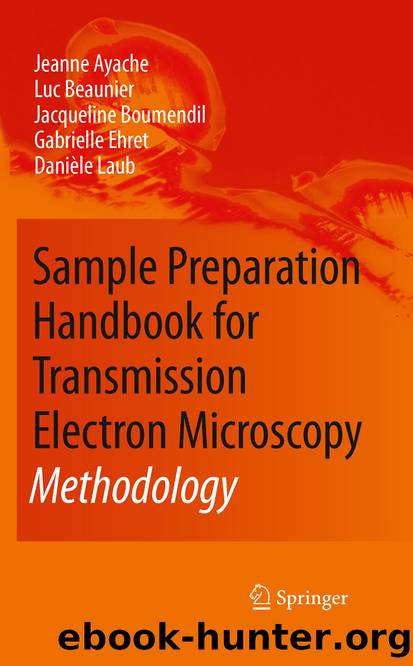Sample Preparation Handbook for Transmission Electron Microscopy by Jeanne Ayache Luc Beaunier Jacqueline Boumendil Gabrielle Ehret & Danièle Laub

Author:Jeanne Ayache, Luc Beaunier, Jacqueline Boumendil, Gabrielle Ehret & Danièle Laub
Language: eng
Format: epub
Publisher: Springer New York, New York, NY
Like water, ice is capable of migrating if the frozen system is not maintained at a temperature low enough to prevent the diffusion phenomenon. For pure water above 140 K, ice crystals are able to become larger, slowly at first, and then quickly as the temperature rises to around 200 K. Then cubic ice crystals appear. This is in the neighborhood of the Tg of vitreous ice (between 120 and 140 K). In a biological-type heterogeneous system (whose diffusion rate is low), experience shows that this phenomenon occurs around 183 K.
Once water is frozen in the best possible way, one of three preparation pathways can be carried out to observe the sample.
If the sample is made up of small fine particles, it can be observed directly in the vitreous ice layer using a cooled specimen holder on the microscope (in the second volume “Techniques”, Chapter 6, Section 2). If it is a bulk sample, it must be sliced. We can obtain thin slices directly by means of cryo-ultramicrotomy (“Techniques”, Chapter 4, Section 5). Otherwise the sample must be embedded in a low-temperature polymerizable resin in order to harden it. In this case, the sample must be dehydrated or desiccated beforehand. Dehydration occurs at low temperatures by substituting ice in a solvent; this is called cryo-substitution. Desiccation is carried out by means of sublimation (freeze drying). They will be followed both by infiltration and inclusion, also at low temperatures (see Prior Preparation in “Techniques”, Chapter 2, Section 10).
Download
This site does not store any files on its server. We only index and link to content provided by other sites. Please contact the content providers to delete copyright contents if any and email us, we'll remove relevant links or contents immediately.
| Concrete | Extraction & Processing |
| Fracture Mechanics | Materials Science |
| Metallurgy | Polymers & Textiles |
| Strength of Materials | Testing |
Whiskies Galore by Ian Buxton(40332)
Introduction to Aircraft Design (Cambridge Aerospace Series) by John P. Fielding(32338)
Small Unmanned Fixed-wing Aircraft Design by Andrew J. Keane Andras Sobester James P. Scanlan & András Sóbester & James P. Scanlan(32141)
Craft Beer for the Homebrewer by Michael Agnew(17446)
Turbulence by E. J. Noyes(7039)
The Complete Stick Figure Physics Tutorials by Allen Sarah(6638)
Kaplan MCAT General Chemistry Review by Kaplan(6054)
The Thirst by Nesbo Jo(5785)
Bad Blood by John Carreyrou(5769)
Learning SQL by Alan Beaulieu(5412)
Weapons of Math Destruction by Cathy O'Neil(5037)
Man-made Catastrophes and Risk Information Concealment by Dmitry Chernov & Didier Sornette(4736)
iGen by Jean M. Twenge(4702)
Digital Minimalism by Cal Newport;(4542)
Life 3.0: Being Human in the Age of Artificial Intelligence by Tegmark Max(4507)
Audition by Ryu Murakami(4099)
1,001 ASVAB Practice Questions For Dummies by Powers Rod(4038)
Electronic Devices & Circuits by Jacob Millman & Christos C. Halkias(4027)
Pale Blue Dot by Carl Sagan(4001)
